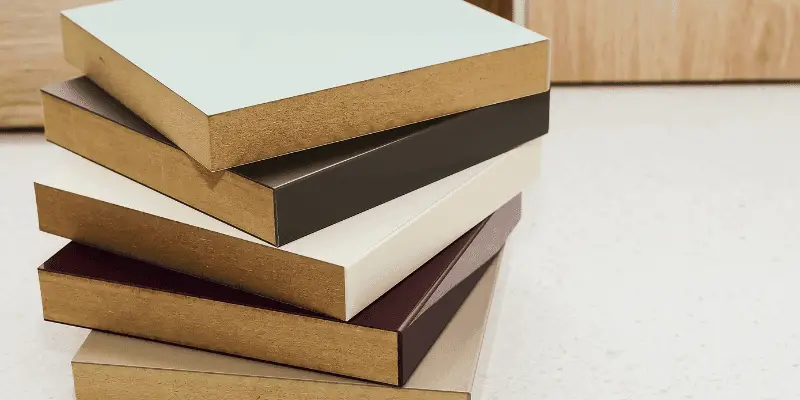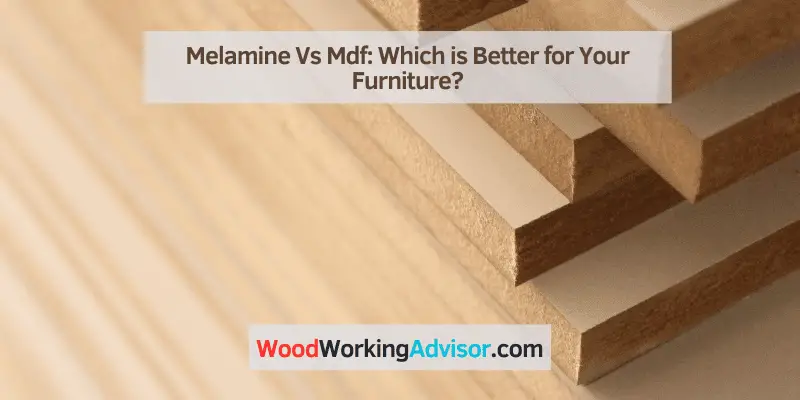Melamine and MDF are both popular materials for furniture and cabinetry. Melamine is a type of plastic coating applied to a substrate, often particleboard or MDF, to give it a durable and scratch-resistant finish.
On the other hand, MDF stands for Medium Density Fiberboard, which is an engineered wood product made by breaking down softwood or hardwood residuals into wood fibers and combining them with wax and resin. Both materials have their own unique characteristics and advantages, making them suitable for different applications.
We will explore the differences between melamine and MDF, their strengths and limitations, and which one may be best for various projects.
Understanding Melamine
Melamine and MDF (Medium-Density Fiberboard) are among the most commonly used materials in the furniture industry. In this post, we will delve into the specifics of melamine – its definition, properties, and applications in furniture. Understanding melamine is crucial for anyone involved in furniture manufacturing or interested in knowing more about the materials used in furniture production.

Definition Of Melamine
Melamine is a type of resin that is commonly used as a decorative overlay for panels, particularly MDF and particleboard. It is made by combining melamine, a crystalline powder, with formaldehyde under high pressure and temperature.
Properties Of Melamine
Melamine possesses several important properties that make it a popular choice for furniture production:
- Durability: Melamine is highly resistant to scratches, stains, and heat, making it an ideal material for surfaces that endure everyday wear and tear.
- Versatility: It can be manufactured in various colors, patterns, and textures, offering flexibility in design and aesthetic appeal.
- Easy maintenance: Its smooth, non-porous surface makes cleaning a breeze, requiring minimal maintenance over time.
Applications Of Melamine In Furniture
Melamine is widely used in the production of furniture, cabinets, shelving, and fixtures due to its versatility and durability. Its applications include:
- Surface Finishing: Melamine is commonly used as a surface finish for MDF and particleboard to achieve a decorative and durable exterior.
- Cabinets and Wardrobes: Melamine-coated panels are often used in the construction of cabinets and wardrobes due to their resistance to moisture and durability.
- Shelving: The smooth and hardwearing nature of melamine makes it an ideal material for shelving used in retail, residential, and commercial spaces.
- Furniture Components: Melamine is utilized for furniture components such as drawer bottoms, shelves, and tabletops, providing both strength and visual appeal.
Unveiling Mdf
Medium Density Fiberboard (MDF) is a versatile and cost-effective composite wood product. It is made from wood fibers and resin, compressed under high pressure and temperature to create a smooth, uniform surface. MDF is widely used in the furniture industry for its durability, stability, and ease of shaping.
Definition Of Medium Density Fiberboard (MDF)
MDF is an engineered wood product made from recycled wood fibers, combined with wax and a resin binder. The resulting panel has a consistent density and smooth surface, making it ideal for various applications.
Properties Of Mdf
- MDF has a uniform texture and homogeneous structure, making it easy to cut, drill, and shape without splintering.
- It offers excellent dimensional stability, minimizing warping, cracking, and swelling when exposed to changes in humidity or temperature.
- MDF panels have a smooth and flat surface, suitable for painting, laminating, or veneering to achieve different finishes.
- Due to its dense composition, MDF provides a strong and stable base for screws, nails, and other fasteners.
- It can be machined and molded into intricate designs, making it a popular choice for decorative elements in furniture and interior applications.
Applications Of Mdf In Furniture
MDF is commonly used in the construction of furniture due to its adaptability and versatility. It is used for:
- Cabinet Doors: MDF offers a smooth surface for painting or adding decorative finishes.
- Shelves: The dimensional stability of MDF makes it suitable for supporting heavy loads.
- Tabletops: MDF provides a flat and sturdy surface for dining tables, coffee tables, and desks.
- Paneling: MDF panels are used for wall cladding and decorative moldings in furniture design.
- Drawer Fronts: Its uniform composition allows for intricate detailing and custom designs.
A Comparative Analysis
When it comes to choosing between melamine and MDF (Medium Density Fiberboard), it’s crucial to assess their key attributes to make an informed decision. This comparative analysis will delve into the essential aspects of durability, cost-effectiveness, and aesthetics and customization options for both these materials.
Durability Comparison
When it comes to durability, MDF is known for its high strength and resistance to warping, cracking, and splitting. However, it is susceptible to moisture damage, making it less suitable for environments with high humidity.
On the other hand, melamine is highly durable and moisture-resistant, making it ideal for use in kitchens and bathrooms. Its ability to withstand wear and tear makes it a popular choice for high-traffic areas.
Cost-effectiveness Comparison
MDF is a cost-effective option, as it is an affordable alternative to solid wood while offering a smooth and uniform surface for finishing. It provides good value for money, especially in projects with budget constraints.
Melamine, while slightly pricier than MDF, provides excellent value due to its durability and low maintenance requirements. Its longevity and resistance to wear make it a worthwhile investment in the long run.
Aesthetics And Customization Options
MDF offers versatility in terms of customization, as it can be easily shaped, painted, or veneered to achieve various designs and finishes. It provides a smooth surface for painting and is suitable for intricate detailing and molding.
Melamine also offers a wide range of customization options, with its availability in various colors, textures, and finishes. It provides a sleek and modern aesthetic, making it a preferred choice for contemporary interiors.
Environmental Impact & Maintenance
When it comes to furniture materials, the environmental impact and maintenance requirements are critical factors to consider. Here, we will take a closer look at the sustainability and environmental impact of melamine and MDF furniture, as well as their maintenance requirements.
Sustainability And Environmental Impact
Both melamine and MDF have different environmental impacts and sustainability factors. Melamine, often made from paper and resin, offers a more sustainable option as it is derived from renewable resources. On the other hand, MDF, made from wood fibers and resin, may have a higher environmental impact due to the use of wood and resin combined in its production. It’s important to weigh these factors according to your environmental priorities.
Maintenance Requirements For Melamine And Mdf Furniture
When it comes to maintenance, both melamine and MDF furniture have their specific requirements. Melamine furniture is known for its durability and resistance to scratches, making it easy to clean and maintain. On the other hand, MDF furniture may require more care, as it is susceptible to water damage and can be easily scratched or dented.
Frequently Asked Questions On Melamine Vs Mdf
What Are The Key Differences Between Melamine And Mdf?
Melamine is a type of finish used on MDF, while MDF refers to the board itself. Melamine is a durable, scratch-resistant finish, while MDF is a versatile engineered wood product, suitable for a wide range of applications.
Can Melamine And Mdf Be Used Together In Furniture Production?
Yes, melamine is commonly used as a finishing material on MDF board to create stylish, durable furniture pieces. The combination offers the benefits of a smooth, attractive finish (melamine) with the strength and versatility of MDF.
Are Melamine And Mdf Materials Eco-friendly And Sustainable Choices?
Both melamine and MDF have the potential for environmental impact and should be sourced from sustainable suppliers. However, MDF is often a more eco-friendly choice compared to natural wood, as it is primarily made from recycled wood fibers and resin.
Conclusion
Both melamine and MDF have their unique qualities and are suitable for different applications. It’s essential to understand your specific needs and budget constraints when making a choice between the two. By considering factors like durability, cost, and aesthetic appeal, you can make an informed decision that best suits your project.


